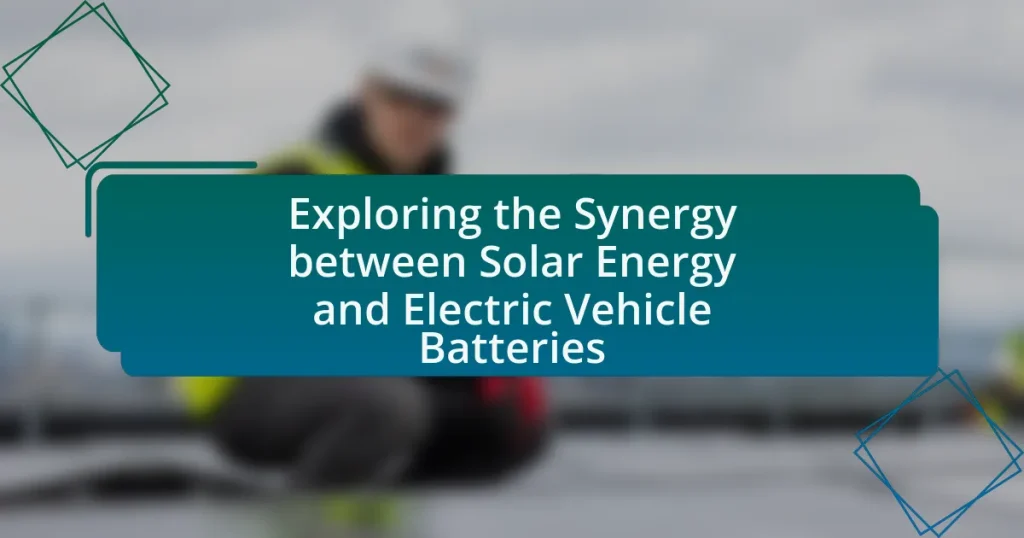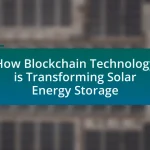The article explores the synergy between solar energy and electric vehicle (EV) batteries, highlighting their complementary roles in promoting sustainable energy systems. It details how solar energy can charge EV batteries, reducing reliance on fossil fuels and lowering greenhouse gas emissions. Key components of solar energy systems for EV charging, such as solar panels, inverters, and battery storage, are discussed, along with the environmental benefits of this integration. The article also addresses the efficiency of energy storage, the impact of advanced battery technologies, and practical steps for consumers to leverage this synergy, ultimately emphasizing the potential for significant cost savings and enhanced energy independence.
What is the synergy between solar energy and electric vehicle batteries?
The synergy between solar energy and electric vehicle batteries lies in their complementary roles in sustainable energy systems. Solar energy provides a renewable source of electricity that can be used to charge electric vehicle batteries, reducing reliance on fossil fuels and lowering greenhouse gas emissions. For instance, studies show that integrating solar panels with electric vehicle charging stations can significantly decrease the carbon footprint of transportation, as solar energy is abundant and clean. Additionally, electric vehicle batteries can serve as energy storage systems, allowing excess solar energy to be stored and used during periods of low sunlight, thus enhancing grid stability and efficiency. This interdependence fosters a more sustainable energy ecosystem, promoting the use of renewable resources in transportation.
How do solar energy systems integrate with electric vehicle batteries?
Solar energy systems integrate with electric vehicle batteries by allowing the direct charging of the batteries using electricity generated from solar panels. This integration typically involves the use of inverters that convert the direct current (DC) produced by solar panels into alternating current (AC) for household use, while also enabling the charging of EV batteries through dedicated charging stations that can accept DC input.
The efficiency of this integration is enhanced by smart charging technology, which optimizes the charging process based on solar energy availability and battery status. According to the U.S. Department of Energy, solar-powered EV charging can significantly reduce greenhouse gas emissions and reliance on fossil fuels, demonstrating the environmental benefits of this synergy.
What are the key components of solar energy systems used for EV charging?
The key components of solar energy systems used for EV charging include solar panels, an inverter, a charge controller, and a battery storage system. Solar panels convert sunlight into electricity, which is then transformed from direct current (DC) to alternating current (AC) by the inverter, making it suitable for EV charging. The charge controller regulates the flow of electricity to prevent overcharging and ensure efficient energy use. Additionally, the battery storage system stores excess energy generated during the day for use when sunlight is not available, enhancing the reliability of the charging system. These components work together to create an efficient and sustainable solution for charging electric vehicles using solar energy.
How do electric vehicle batteries store energy generated from solar panels?
Electric vehicle batteries store energy generated from solar panels through a process of charging. When solar panels convert sunlight into electricity, this energy can be directed to charge the batteries of electric vehicles. The batteries, typically lithium-ion, utilize chemical reactions to store this electrical energy for later use in powering the vehicle. This process is efficient, as it allows for the direct use of renewable energy, reducing reliance on fossil fuels and lowering greenhouse gas emissions.
What are the environmental benefits of combining solar energy with electric vehicle batteries?
Combining solar energy with electric vehicle batteries significantly reduces greenhouse gas emissions. This integration allows for the storage of renewable energy generated from solar panels, which can then be used to charge electric vehicles, thereby decreasing reliance on fossil fuels. According to the U.S. Department of Energy, using solar energy for electric vehicle charging can reduce carbon emissions by up to 70% compared to conventional gasoline vehicles. Additionally, this synergy promotes energy independence and enhances grid stability by utilizing distributed energy resources, which further contributes to a cleaner environment.
How does this synergy contribute to reducing carbon emissions?
The synergy between solar energy and electric vehicle batteries significantly contributes to reducing carbon emissions by enabling the use of renewable energy for transportation. When electric vehicles are charged using solar power, the reliance on fossil fuels for electricity generation decreases, leading to lower greenhouse gas emissions. For instance, a study by the National Renewable Energy Laboratory found that integrating solar energy with electric vehicle charging can reduce carbon emissions by up to 70% compared to conventional gasoline vehicles. This reduction is primarily due to the cleaner energy source and the increased efficiency of electric vehicles compared to internal combustion engines.
What impact does it have on sustainable energy practices?
The synergy between solar energy and electric vehicle batteries significantly enhances sustainable energy practices by promoting energy efficiency and reducing reliance on fossil fuels. This integration allows for the storage of solar energy in electric vehicle batteries, which can then be used to power homes or charge vehicles, thereby decreasing greenhouse gas emissions. According to a study by the International Energy Agency, the combination of solar energy and electric vehicles can lead to a reduction of up to 70% in carbon emissions compared to traditional energy sources. This demonstrates that the collaboration between these technologies not only supports renewable energy adoption but also contributes to a more sustainable energy ecosystem.
How does the synergy between solar energy and electric vehicle batteries enhance energy efficiency?
The synergy between solar energy and electric vehicle batteries enhances energy efficiency by enabling the direct use of solar power to charge the batteries, reducing reliance on grid electricity. This integration allows for the storage of renewable energy generated during the day, which can then be utilized for vehicle operation or home energy needs, thereby minimizing energy loss associated with traditional energy transfer methods. Studies indicate that using solar energy for electric vehicle charging can lead to a reduction in greenhouse gas emissions by up to 70%, demonstrating significant environmental and efficiency benefits.
What role does energy storage play in this synergy?
Energy storage is crucial in the synergy between solar energy and electric vehicle batteries as it enables the efficient use and management of renewable energy. By storing excess solar energy generated during peak sunlight hours, energy storage systems ensure that this energy can be utilized later, particularly when solar generation is low or demand is high. This capability enhances grid stability and reduces reliance on fossil fuels, as evidenced by studies showing that integrating energy storage with solar can increase renewable energy utilization by up to 30%.
How do battery technologies affect the efficiency of solar energy utilization?
Battery technologies significantly enhance the efficiency of solar energy utilization by enabling effective energy storage and management. Advanced battery systems, such as lithium-ion and solid-state batteries, allow for the capture of excess solar energy generated during peak sunlight hours, which can then be used during periods of low sunlight or high demand. This capability reduces reliance on the grid and maximizes the use of renewable energy. For instance, studies indicate that integrating high-capacity batteries with solar systems can increase overall energy efficiency by up to 30%, as they facilitate better load balancing and energy dispatch.
What are the challenges in optimizing energy storage for solar-powered EVs?
The challenges in optimizing energy storage for solar-powered electric vehicles (EVs) include limited energy density, variability in solar energy generation, and the high cost of advanced battery technologies. Limited energy density restricts the amount of energy that can be stored, impacting the driving range of solar-powered EVs. Variability in solar energy generation due to weather conditions and time of day complicates the reliability of energy supply, necessitating robust energy management systems. Additionally, the high cost of advanced battery technologies, such as lithium-sulfur or solid-state batteries, poses a financial barrier to widespread adoption and optimization of energy storage solutions for solar-powered EVs.
How can consumers benefit from this synergy?
Consumers can benefit from the synergy between solar energy and electric vehicle batteries through reduced energy costs and increased energy independence. By integrating solar panels with electric vehicle charging systems, consumers can generate their own electricity, significantly lowering their reliance on grid power and decreasing monthly utility bills. For instance, a study by the National Renewable Energy Laboratory found that homeowners with solar panels can save an average of $1,500 annually on energy costs. Additionally, this synergy allows consumers to charge their electric vehicles using clean, renewable energy, further enhancing sustainability and reducing carbon footprints.
What cost savings can be achieved by using solar energy for EV charging?
Using solar energy for EV charging can achieve significant cost savings, primarily by reducing electricity bills and minimizing reliance on grid power. For instance, studies indicate that homeowners can save between 50% to 100% on charging costs by utilizing solar panels, depending on their energy consumption and the size of their solar installation. Additionally, the average cost of electricity for charging an EV from the grid is about $0.13 per kWh, while solar energy can reduce this cost to nearly zero after the initial investment in solar technology. Furthermore, government incentives and tax credits for solar installations can further enhance these savings, making solar energy a financially advantageous option for EV charging.
How does this synergy influence the overall ownership experience of electric vehicles?
The synergy between solar energy and electric vehicle batteries significantly enhances the overall ownership experience of electric vehicles by reducing charging costs and increasing energy independence. This integration allows electric vehicle owners to harness solar power for charging, which can lower electricity expenses by up to 50% compared to traditional grid charging, as reported by the National Renewable Energy Laboratory. Additionally, utilizing solar energy contributes to a more sustainable lifestyle, aligning with the environmental values of many electric vehicle owners. This combination not only provides financial benefits but also fosters a sense of autonomy and responsibility towards renewable energy usage.
What are the future trends in the synergy between solar energy and electric vehicle batteries?
Future trends in the synergy between solar energy and electric vehicle batteries include increased integration of solar panels into EV designs, advancements in vehicle-to-grid technology, and enhanced energy storage solutions. As manufacturers develop solar-integrated vehicles, such as those with solar roofs, the ability to harness solar energy for charging will improve, reducing reliance on grid electricity. Vehicle-to-grid technology will enable EVs to not only draw power from the grid but also supply energy back, facilitating a more sustainable energy ecosystem. Additionally, innovations in battery technology, such as solid-state batteries, will enhance energy density and charging efficiency, further promoting the use of solar energy in powering electric vehicles. These trends are supported by the growing demand for renewable energy solutions and the global push for decarbonization in transportation.
How is technology evolving to improve this synergy?
Technology is evolving to improve the synergy between solar energy and electric vehicle batteries through advancements in energy storage systems and smart grid integration. Innovations such as lithium-sulfur and solid-state batteries are enhancing energy density and charging efficiency, allowing electric vehicles to store more solar energy for longer periods. Additionally, the development of vehicle-to-grid (V2G) technology enables electric vehicles to return excess energy back to the grid, optimizing energy use and reducing waste. According to a report by the International Energy Agency, the integration of renewable energy sources with electric vehicle infrastructure can significantly reduce greenhouse gas emissions, demonstrating the effectiveness of this technological evolution.
What innovations are being developed in solar panel and battery technology?
Innovations in solar panel and battery technology include the development of bifacial solar panels, which capture sunlight from both sides, and solid-state batteries that offer higher energy density and safety. Bifacial panels can increase energy generation by up to 30% compared to traditional panels, as they utilize reflected sunlight from surfaces below. Solid-state batteries, on the other hand, replace liquid electrolytes with solid materials, significantly reducing the risk of fire and improving longevity, with some prototypes achieving over 1,000 charge cycles. These advancements are crucial for enhancing the efficiency and safety of solar energy systems and electric vehicle batteries, aligning with the growing demand for sustainable energy solutions.
How might government policies impact the growth of this synergy?
Government policies can significantly impact the growth of the synergy between solar energy and electric vehicle batteries by providing financial incentives and regulatory frameworks that promote their integration. For instance, subsidies for solar panel installation and tax credits for electric vehicle purchases encourage consumers to adopt these technologies, thereby increasing demand and fostering innovation in both sectors. Additionally, policies that mandate renewable energy usage and set emissions targets can drive investments in solar energy and battery storage solutions, facilitating a more robust infrastructure for electric vehicles. Historical data shows that countries with supportive policies, such as Germany and California, have seen accelerated growth in solar energy adoption and electric vehicle sales, demonstrating the effectiveness of government intervention in enhancing this synergy.
What practical steps can individuals take to leverage this synergy?
Individuals can leverage the synergy between solar energy and electric vehicle batteries by installing solar panels at home to charge their electric vehicles. This practice reduces reliance on grid electricity, lowers energy costs, and maximizes the use of renewable energy. According to the U.S. Department of Energy, using solar energy to charge electric vehicles can save owners up to $1,000 annually on fuel costs, demonstrating the financial benefits of this approach. Additionally, individuals can participate in community solar programs, which allow them to benefit from solar energy even if they cannot install panels on their property, further enhancing their ability to utilize this synergy effectively.
How can homeowners install solar systems to charge their electric vehicles effectively?
Homeowners can install solar systems to charge their electric vehicles effectively by integrating solar panels with a dedicated electric vehicle charging station. This setup allows homeowners to harness solar energy to power their EVs directly, reducing reliance on the grid and lowering electricity costs.
To achieve this, homeowners should first assess their energy needs and the solar panel capacity required to meet those needs. A typical electric vehicle requires about 30 kWh to travel 100 miles, so the solar system should be sized accordingly, often around 5 to 10 kW, depending on driving habits and local sunlight availability.
Additionally, homeowners should consider installing a solar inverter that converts the direct current (DC) generated by solar panels into alternating current (AC) suitable for charging the vehicle. Using a Level 2 charging station can further enhance charging efficiency, allowing for faster charging times.
Research indicates that solar energy can significantly offset the cost of charging electric vehicles, with studies showing that homeowners can save up to 70% on charging costs when using solar power. This synergy not only promotes sustainability but also increases the overall value of the property.
What are the best practices for maintaining solar energy systems and EV batteries?
The best practices for maintaining solar energy systems and EV batteries include regular inspections, cleaning, and monitoring of performance metrics. Solar energy systems should be inspected at least twice a year to check for any physical damage, loose connections, or debris that could obstruct sunlight. Cleaning the solar panels periodically ensures optimal energy absorption, as dirt and grime can significantly reduce efficiency.
For EV batteries, maintaining optimal temperature ranges is crucial, as extreme temperatures can degrade battery life. Regularly checking the battery management system for updates and ensuring proper charging practices, such as avoiding deep discharges and using appropriate chargers, can enhance battery longevity.
Research indicates that proper maintenance can extend the lifespan of solar panels to 25 years or more and increase the efficiency of EV batteries by up to 30% (National Renewable Energy Laboratory, 2020).


